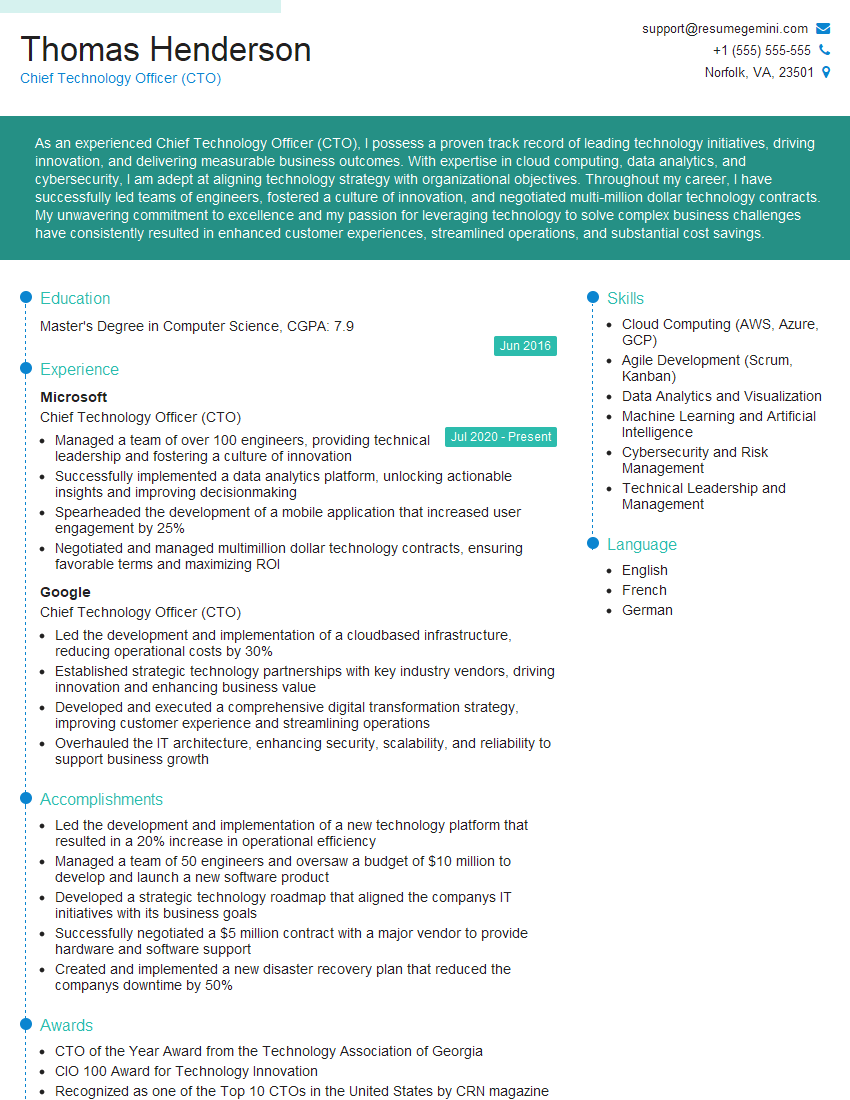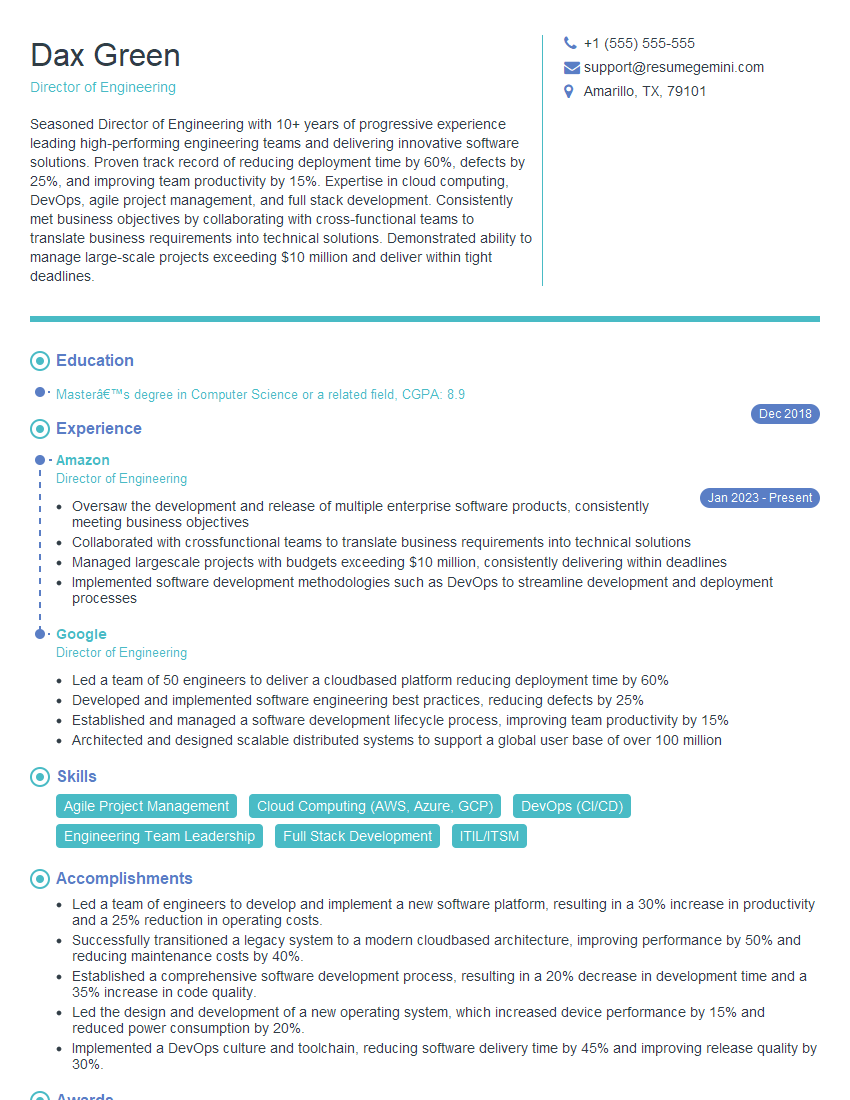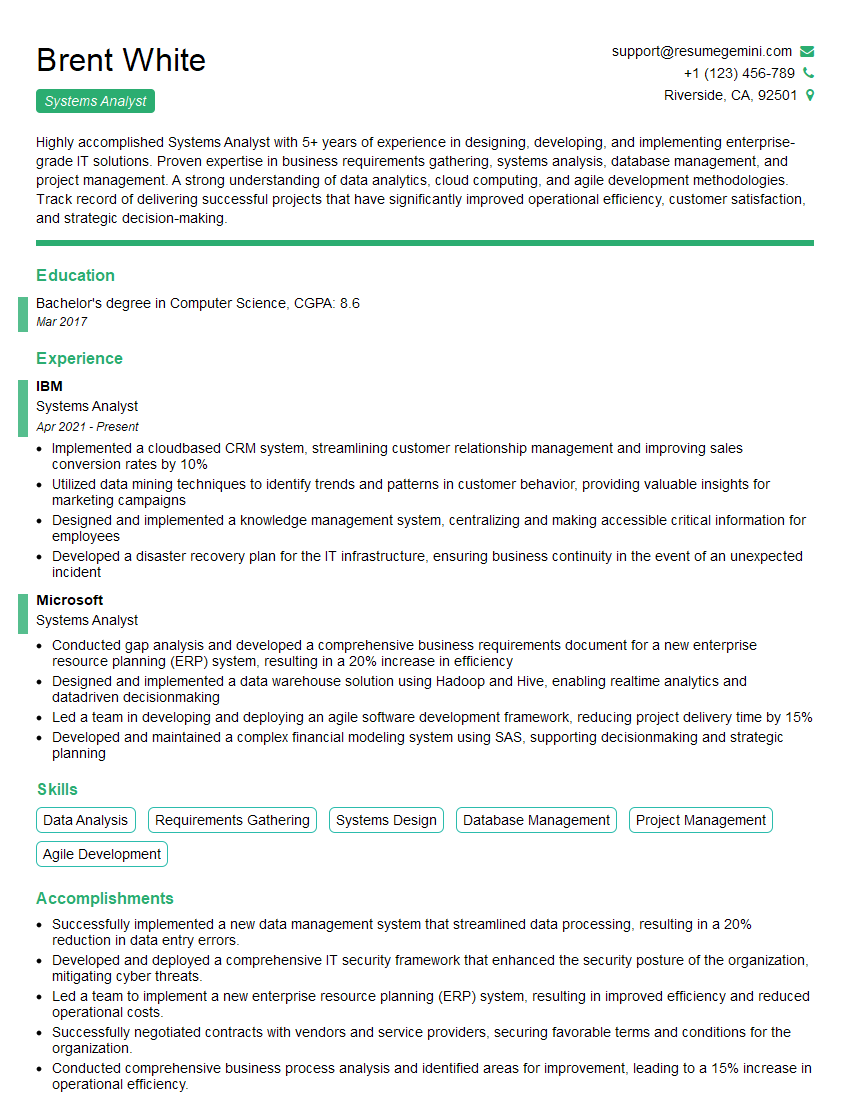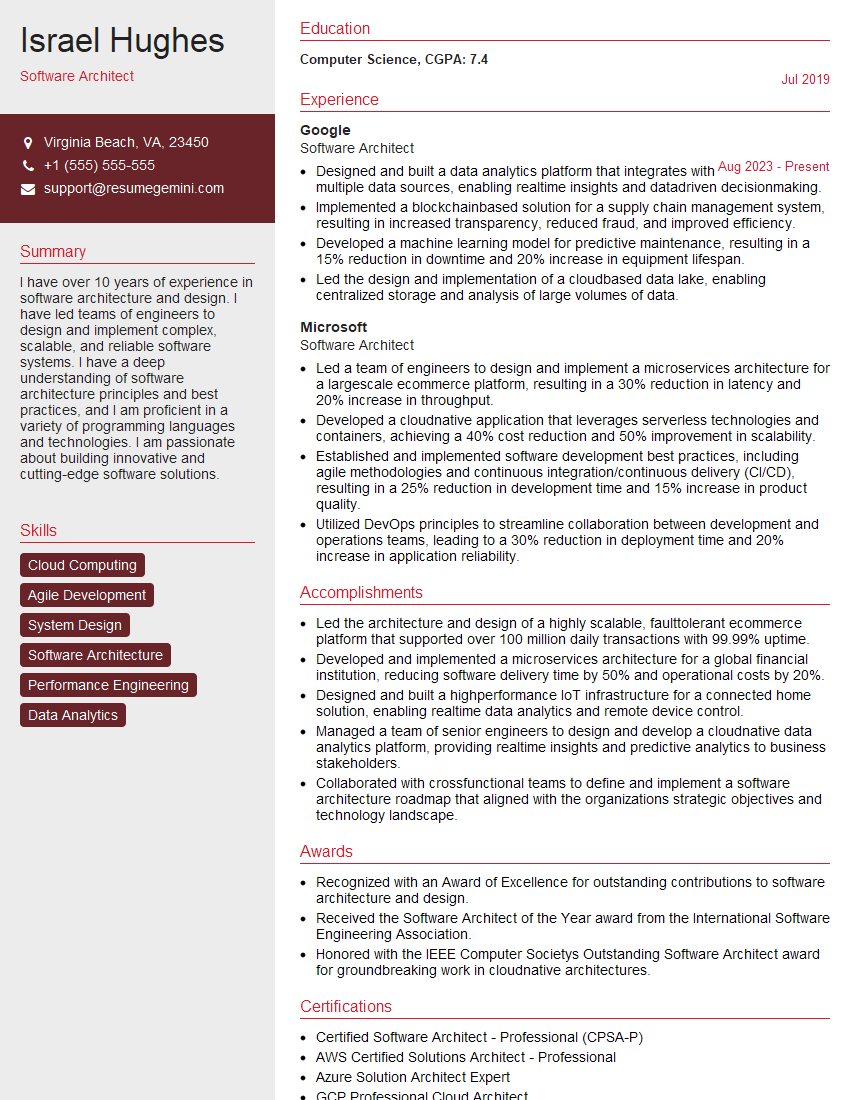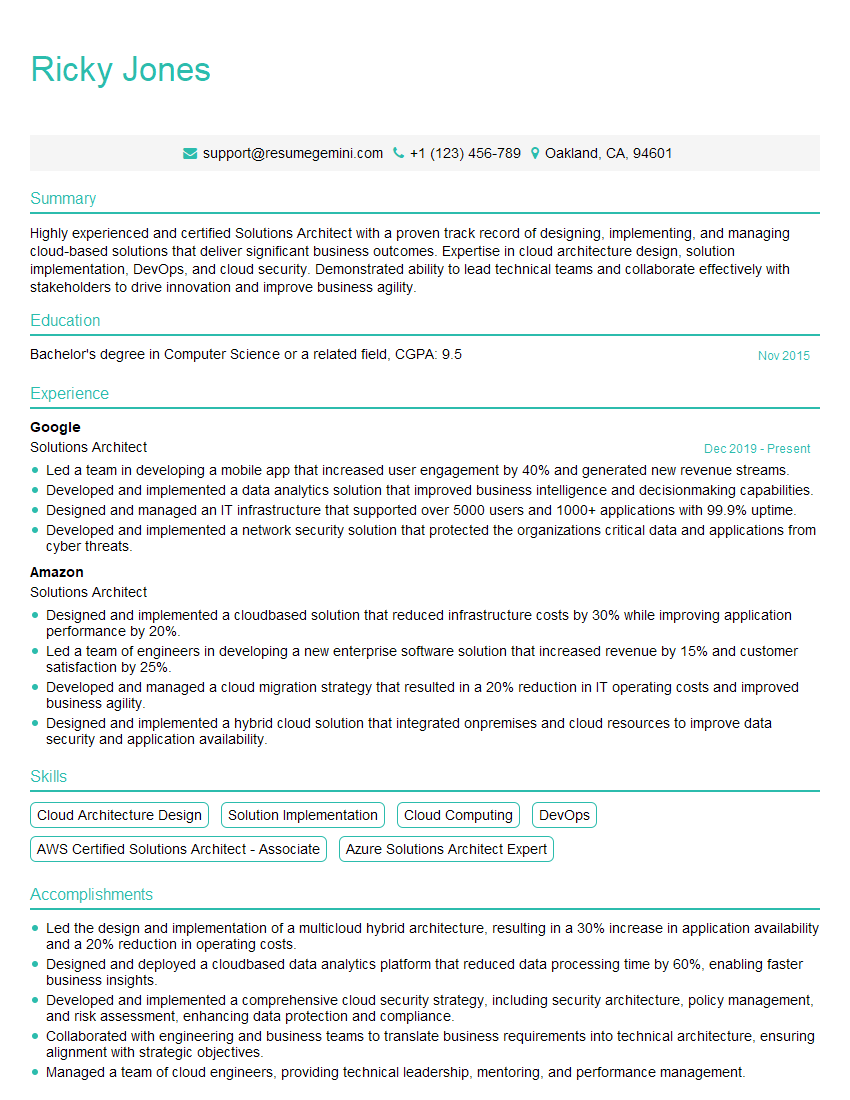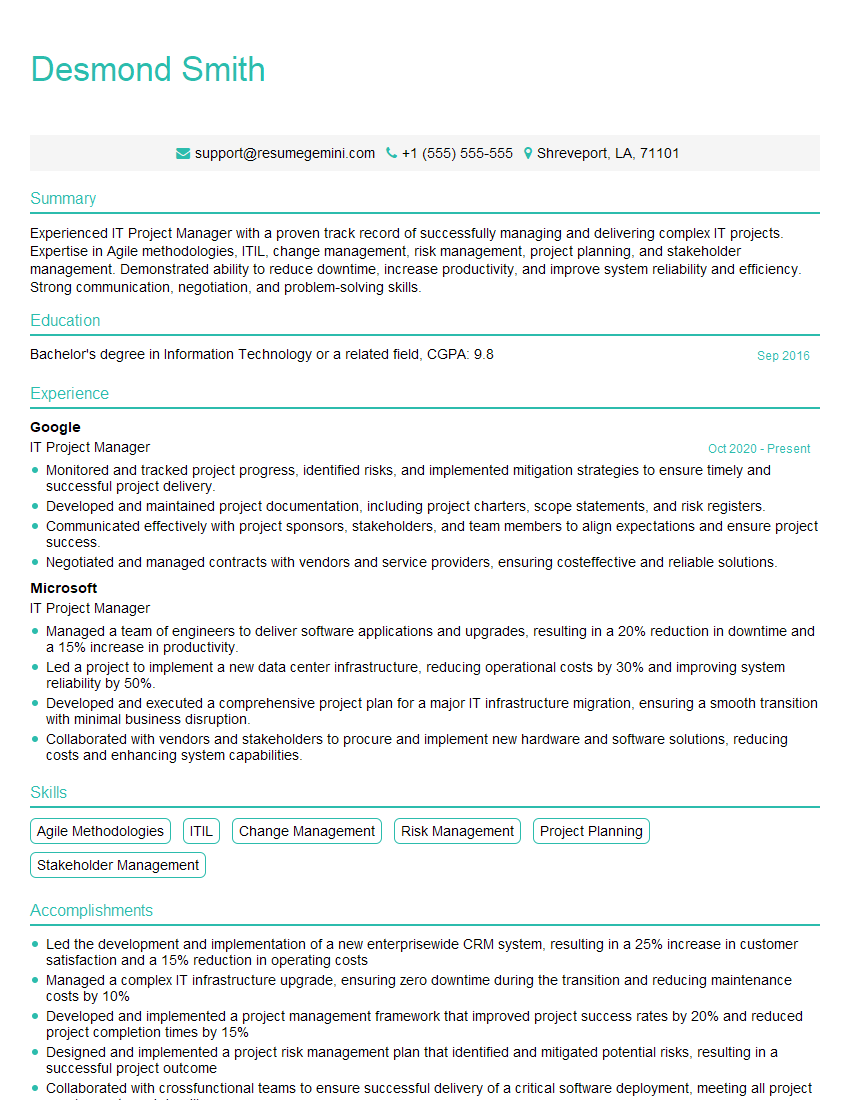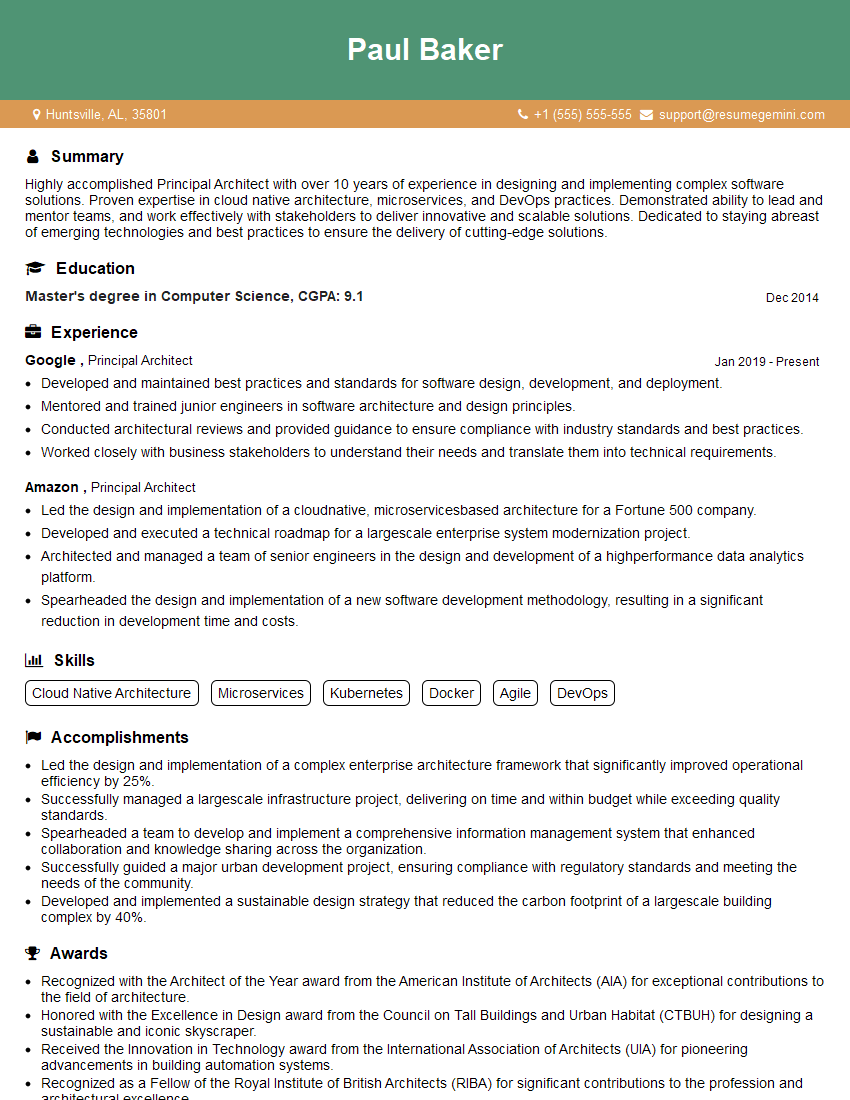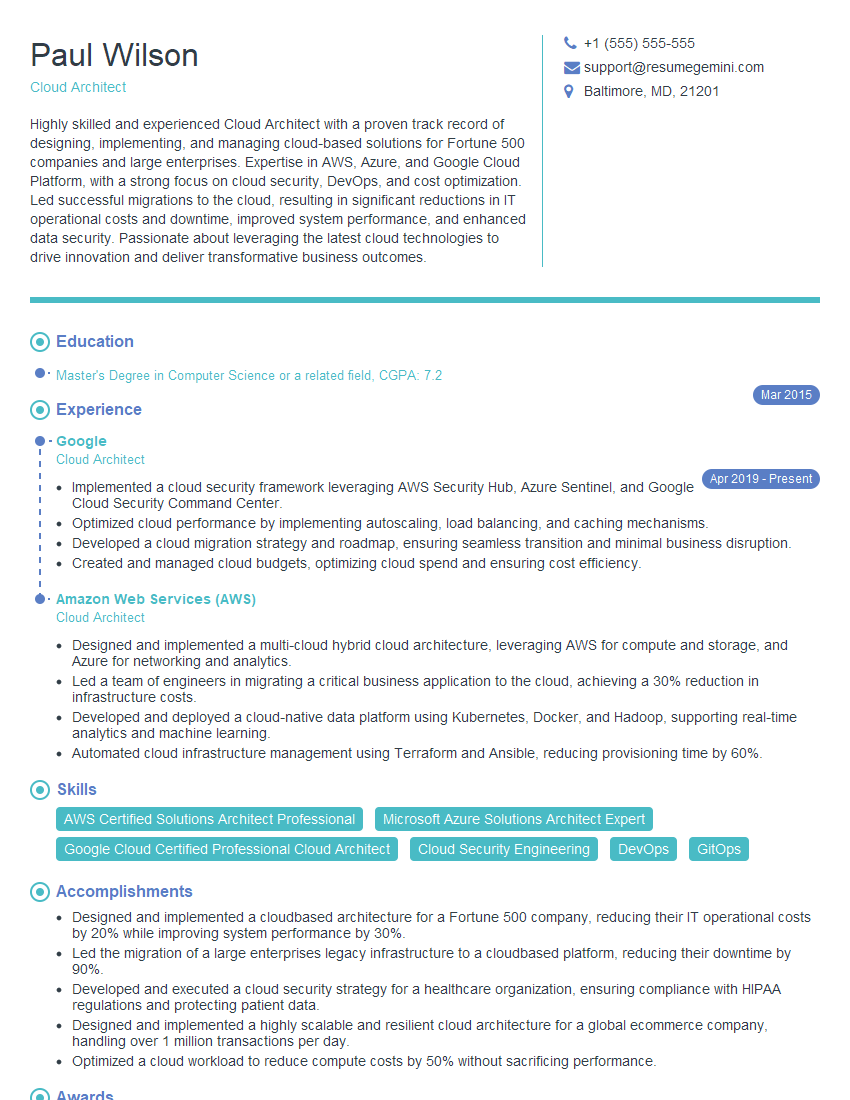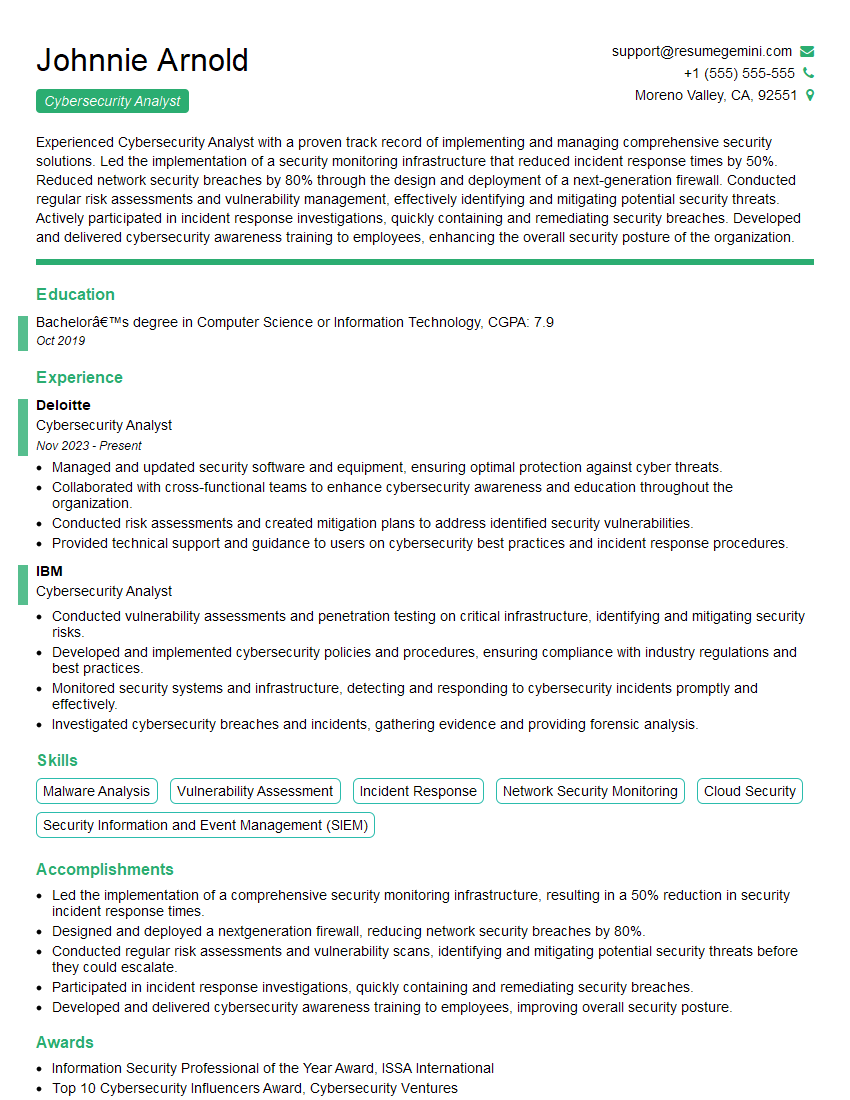The right preparation can turn an interview into an opportunity to showcase your expertise. This guide to Up-to-date knowledge of industry best practices and emerging technologies interview questions is your ultimate resource, providing key insights and tips to help you ace your responses and stand out as a top candidate.
Questions Asked in Up-to-date knowledge of industry best practices and emerging technologies Interview
Q 1. Explain your understanding of Agile methodologies and their practical application.
Agile methodologies are iterative approaches to software development and project management that prioritize flexibility, collaboration, and customer satisfaction. Instead of rigid, sequential plans, Agile emphasizes incremental progress through short cycles called sprints. Popular frameworks include Scrum and Kanban.
- Scrum uses defined roles (Product Owner, Scrum Master, Development Team) and events (Sprint Planning, Daily Scrum, Sprint Review, Sprint Retrospective) to manage iterative development sprints.
- Kanban focuses on visualizing workflow, limiting work in progress, and continuously improving the process. It’s more flexible than Scrum and adapts well to existing workflows.
In practice, Agile helps teams respond quickly to changing requirements, deliver value frequently, and improve product quality through continuous feedback. For example, imagine developing a mobile app. Instead of designing the entire app upfront and building it in one go, an Agile approach would involve breaking it into smaller features (e.g., login, profile creation, core functionality). Each feature is developed and tested in a sprint, with customer feedback incorporated before moving to the next. This reduces the risk of building the wrong product and allows for adaptation based on user needs.
Q 2. Describe your experience with DevOps and CI/CD pipelines.
DevOps is a set of practices that automate and integrate the processes between software development and IT operations teams. The goal is to shorten the systems development life cycle and provide continuous delivery with high software quality. CI/CD pipelines are crucial to DevOps. CI (Continuous Integration) focuses on automating the build and testing of code, while CD (Continuous Delivery/Deployment) automates the release and deployment processes.
My experience involves using tools like Jenkins, GitLab CI, and Azure DevOps to build CI/CD pipelines. I’ve worked with various technologies including Docker for containerization, Kubernetes for orchestration, and infrastructure-as-code tools like Terraform. For instance, in a previous project, we implemented a CI/CD pipeline that automatically built, tested, and deployed our application to multiple environments (development, staging, production) upon each code commit. This ensured rapid iteration, minimized errors, and increased the frequency of releases.
Example: A Jenkins pipeline might include stages for building the code, running unit tests, performing integration tests, deploying to a staging environment, running acceptance tests, and finally deploying to production.Q 3. What are some current best practices in cybersecurity?
Current best practices in cybersecurity emphasize a multi-layered, proactive approach. It’s no longer enough to just react to breaches; organizations must actively prevent them.
- Zero Trust Security: Assume no user or device is inherently trustworthy, verifying every access request regardless of location.
- Regular Security Audits and Penetration Testing: Identifying vulnerabilities before attackers do.
- Strong Authentication and Authorization: Multi-factor authentication (MFA) and least privilege access control are essential.
- Data Loss Prevention (DLP): Implementing measures to prevent sensitive data from leaving the organization’s control.
- Security Awareness Training: Educating employees about phishing scams, social engineering, and other threats.
- Incident Response Planning: Having a detailed plan to handle security incidents effectively.
- Regular Software Updates and Patching: Keeping systems up-to-date to mitigate known vulnerabilities.
- Encryption: Protecting data both in transit and at rest.
For example, a company might implement a Zero Trust architecture where access to internal systems requires MFA and continuous verification of device posture. They would also conduct regular penetration testing to identify and address vulnerabilities before they can be exploited.
Q 4. How familiar are you with cloud computing platforms (AWS, Azure, GCP)?
I have significant experience with all three major cloud platforms: AWS, Azure, and GCP. My expertise includes provisioning resources, configuring networks, deploying applications, and managing databases on each platform. I’m familiar with their respective strengths and weaknesses and can choose the best platform based on project requirements.
- AWS: Extensive services, large community, strong in compute and storage.
- Azure: Good integration with Microsoft products, strong in hybrid cloud solutions.
- GCP: Excellent for big data and machine learning, strong in Kubernetes.
For example, I’ve used AWS Lambda to deploy serverless functions, Azure Kubernetes Service (AKS) to manage containerized applications, and Google Cloud Storage for storing large datasets. My experience spans various services within each platform, enabling me to architect and deploy scalable, reliable, and cost-effective cloud solutions.
Q 5. Discuss the ethical considerations of using AI in your field.
Ethical considerations in AI are paramount. Bias in algorithms, job displacement, privacy concerns, and accountability are major issues.
- Bias in Algorithms: AI models trained on biased data perpetuate and amplify existing societal biases. This can lead to unfair or discriminatory outcomes.
- Job Displacement: Automation driven by AI could lead to significant job losses in certain sectors.
- Privacy Concerns: AI systems often collect and analyze vast amounts of personal data, raising privacy issues.
- Accountability: Determining responsibility when an AI system makes a mistake or causes harm is complex.
To mitigate these issues, we need transparent and explainable AI models, rigorous testing for bias, robust data privacy protections, and clear guidelines for accountability. For example, before deploying an AI system for loan applications, it’s crucial to audit the model for bias and ensure it doesn’t discriminate against certain demographic groups. Furthermore, implementing mechanisms to explain the model’s decisions can increase transparency and build trust.
Q 6. Explain your understanding of blockchain technology and its potential applications.
Blockchain technology is a decentralized, distributed ledger that records transactions across multiple computers. This makes it highly secure and transparent. Each block in the chain contains a timestamp and a hash of the previous block, making it tamper-proof.
Potential applications are numerous and extend beyond cryptocurrencies. Examples include:
- Supply Chain Management: Tracking goods from origin to consumer, ensuring authenticity and transparency.
- Healthcare: Securely storing and sharing patient medical records.
- Digital Identity: Creating secure and verifiable digital identities.
- Voting Systems: Enhancing the security and transparency of elections.
However, scalability, energy consumption, and regulatory challenges remain significant hurdles. For example, a company could use blockchain to track the movement of pharmaceuticals, ensuring that products are not counterfeit and maintaining a transparent record of their journey.
Q 7. How do you stay up-to-date with emerging technologies?
Staying up-to-date with emerging technologies is crucial. I employ a multi-pronged approach:
- Following Industry Publications and Blogs: Reading publications like TechCrunch, Wired, and industry-specific journals.
- Attending Conferences and Workshops: Engaging with experts and learning about the latest advancements firsthand.
- Online Courses and Certifications: Continuously upskilling through platforms like Coursera, edX, and Udacity.
- Participating in Online Communities: Engaging with other professionals on platforms like Stack Overflow and Reddit.
- Experimentation and Hands-on Projects: Putting new technologies into practice to gain practical experience.
This combined approach keeps me informed about the latest trends, challenges, and best practices in various domains. It also allows me to critically assess the potential and limitations of new technologies.
Q 8. Describe a time you had to adapt to a rapidly changing technological landscape.
The rapid shift from monolithic architectures to microservices and the rise of serverless computing presented a significant challenge. I was working on a legacy e-commerce platform that needed a major overhaul to handle increasing traffic and introduce new features quickly. Initially, our team was hesitant to adopt new technologies due to the perceived risk and the learning curve. To overcome this, I championed a phased approach. We started by migrating non-critical modules to microservices, using Docker for containerization and Kubernetes for orchestration. This allowed us to gain experience and confidence before tackling more complex parts of the system. We also implemented continuous integration and continuous delivery (CI/CD) to streamline the development and deployment process. This strategy minimized risk, enabled faster iteration cycles, and allowed us to adapt to the changing landscape successfully. We saw a significant improvement in deployment frequency, reducing deployment time from days to hours. Furthermore, the modularity of the microservices allowed for independent scaling of individual components, leading to improved resource utilization and cost savings.
Q 9. What is your experience with big data technologies and analysis?
My experience with big data technologies spans several areas, including data ingestion, processing, and analysis. I’ve worked extensively with Hadoop ecosystem components like HDFS for storage and Spark for distributed processing. I’m also proficient in using cloud-based big data services such as AWS EMR and Google Cloud Dataproc. For data analysis, I’m fluent in SQL and utilize tools like Python with libraries like Pandas and scikit-learn for data manipulation, exploration, and machine learning model building. For example, in a previous project, we used Spark to process terabytes of customer transaction data to identify fraudulent activities in real-time. We implemented a machine learning model using Spark MLlib, which significantly improved the accuracy of fraud detection compared to our previous rule-based system. This resulted in a considerable reduction in fraudulent transactions and minimized financial losses.
Q 10. Explain your understanding of microservices architecture.
Microservices architecture is a design approach where a large application is structured as a collection of small, independent services. Each service focuses on a specific business function and communicates with other services via lightweight mechanisms, often APIs. Think of it like building with Lego bricks – each brick represents a service, and you can combine them in different ways to build a complex structure. Key advantages include improved scalability, maintainability, and fault isolation. If one service fails, the rest of the application can continue operating. For example, in an e-commerce platform, you might have separate microservices for user authentication, product catalog, order processing, and payment gateway. Each service can be developed, deployed, and scaled independently, allowing for greater flexibility and agility. However, the increased complexity of managing multiple services needs to be considered, requiring robust monitoring and deployment strategies.
Q 11. What are some common design patterns you’ve used, and why?
I frequently utilize several design patterns depending on the specific needs of a project. The Model-View-Controller (MVC) pattern is a staple for separating concerns in web applications, making code more organized and maintainable. The Factory pattern is useful for creating objects without specifying their concrete classes, promoting flexibility. For asynchronous operations and handling concurrent requests, I often employ the Observer and Pub/Sub patterns. For example, in a real-time chat application, the Observer pattern is ideal for updating all clients whenever a new message arrives. The Singleton pattern ensures only one instance of a class exists, useful for managing resources like database connections. Choosing the right pattern depends on the specific problem you’re trying to solve. A well-chosen pattern can dramatically improve code clarity and reusability.
Q 12. How do you ensure code quality and maintainability?
Maintaining code quality and maintainability is crucial. I employ several strategies: First, I strictly adhere to coding standards and style guides to ensure consistency and readability. We use linters and static code analyzers to automatically detect potential issues early in the development process. We prioritize writing unit tests to ensure individual components work as expected and perform integration testing to verify interactions between services. Code reviews are a vital part of our process, helping catch bugs and improve code quality before merging into the main branch. We also utilize continuous integration and continuous deployment (CI/CD) pipelines to automate testing and deployment, ensuring code quality throughout the development lifecycle. Proper documentation, including comments within the code and comprehensive API documentation, is essential for long-term maintainability.
Q 13. Describe your experience with containerization technologies (Docker, Kubernetes).
My experience with containerization technologies like Docker and Kubernetes is extensive. I’ve used Docker to create and manage containers for various applications, simplifying the deployment process and ensuring consistency across different environments. Kubernetes has been invaluable for orchestrating and managing those containers at scale. I’ve used Kubernetes to deploy and manage microservices, leveraging its features for automated scaling, self-healing, and rolling updates. For instance, in a recent project, we migrated a monolith application to a microservices architecture using Docker and Kubernetes. The result was significantly improved scalability, resilience, and faster deployment times. Kubernetes’s ability to manage resource allocation efficiently optimized our infrastructure costs. Furthermore, the declarative nature of Kubernetes manifests enhanced consistency and repeatability in our deployment process.
Q 14. What are some key performance indicators (KPIs) you use to measure success?
The KPIs I use to measure success vary depending on the project context, but some common ones include: deployment frequency, mean time to recovery (MTTR), customer satisfaction (CSAT) scores, application performance metrics (e.g., response time, error rate), resource utilization, and cost efficiency. For example, in a recent project focused on improving website performance, we tracked page load time as a key metric. By optimizing the code and infrastructure, we reduced page load time by 40%, resulting in a noticeable improvement in CSAT scores. For a project focused on cost optimization, we monitored resource utilization and identified areas for improvement, leading to a 20% reduction in cloud infrastructure costs. Regularly tracking and analyzing these KPIs provides valuable insights into project success and areas for continuous improvement.
Q 15. How do you approach problem-solving in a technical context?
My approach to problem-solving in a technical context is systematic and iterative. I start by clearly defining the problem, ensuring I understand its scope and potential impact. This often involves asking clarifying questions and gathering relevant data. Next, I brainstorm potential solutions, considering both short-term fixes and long-term strategies. I evaluate each solution based on feasibility, cost, and potential risks. Once a solution is chosen, I implement it in a controlled manner, testing thoroughly at each stage. Finally, I document the process and results, and continuously monitor for unforeseen issues or areas for improvement. For example, recently I encountered a performance bottleneck in a database query. After profiling the query, I identified a missing index. Implementing the index resulted in a significant performance improvement. This iterative process is key; if the first solution doesn’t work perfectly, I regroup, analyze the results, and refine my approach.
Career Expert Tips:
- Ace those interviews! Prepare effectively by reviewing the Top 50 Most Common Interview Questions on ResumeGemini.
- Navigate your job search with confidence! Explore a wide range of Career Tips on ResumeGemini. Learn about common challenges and recommendations to overcome them.
- Craft the perfect resume! Master the Art of Resume Writing with ResumeGemini’s guide. Showcase your unique qualifications and achievements effectively.
- Don’t miss out on holiday savings! Build your dream resume with ResumeGemini’s ATS optimized templates.
Q 16. Describe your experience with different software development methodologies.
I have extensive experience with various software development methodologies, including Agile (Scrum and Kanban), Waterfall, and DevOps. Agile methodologies, particularly Scrum, are my preferred approach for most projects due to their adaptability and focus on iterative development. I’ve participated in numerous Scrum sprints, utilizing daily stand-ups, sprint reviews, and retrospectives to ensure continuous improvement. Waterfall is suitable for projects with well-defined requirements and minimal expected changes, while DevOps, with its emphasis on automation and continuous integration/continuous delivery (CI/CD), is crucial for maintaining high-quality, rapidly deployable software. In one project, we transitioned from a Waterfall approach to Scrum, resulting in increased team collaboration and faster delivery of value to the client.
Q 17. What is your experience with testing methodologies (unit, integration, system)?
My testing experience encompasses unit, integration, and system testing, and I’m familiar with various testing strategies, including black-box, white-box, and grey-box testing. Unit testing verifies the functionality of individual components in isolation. I use frameworks like JUnit or pytest to write unit tests. Integration testing focuses on the interaction between different components, confirming they work together as expected. System testing verifies the complete system meets its requirements. This frequently includes performance and security testing. I’ve used tools like Selenium and JMeter for automated testing. In a recent project, a thorough integration testing phase revealed a compatibility issue between two modules that wouldn’t have been apparent through unit testing alone, preventing a costly deployment issue.
Q 18. Explain your understanding of data privacy regulations (GDPR, CCPA).
I have a strong understanding of data privacy regulations like GDPR (General Data Protection Regulation) and CCPA (California Consumer Privacy Act). GDPR, applicable in the European Union, focuses on individuals’ rights to control their personal data. CCPA, in California, provides consumers with similar rights. Both regulations mandate data minimization, purpose limitation, and data security measures. Understanding these regulations is critical when designing and implementing software that handles personal data. We must ensure data is collected lawfully, securely stored, and processed transparently. Non-compliance can lead to significant fines and reputational damage. In a project involving user data, I ensured compliance by implementing data encryption, access control measures, and a clear data privacy policy that outlined how user data was collected, used, and protected, in line with both GDPR and CCPA guidelines.
Q 19. How do you handle conflicts or disagreements within a team?
I believe constructive conflict resolution is crucial for team success. My approach focuses on active listening, empathy, and respectful communication. I start by ensuring everyone feels heard and understands each other’s perspectives. Then, I facilitate a collaborative discussion to identify the root cause of the disagreement. We explore various solutions together, focusing on finding a mutually agreeable outcome that aligns with the project’s goals. If a resolution isn’t immediately reached, I may suggest involving a neutral third party to mediate. For example, during a recent project, a disagreement arose about the best technical approach. Instead of letting it escalate, we held a meeting to outline the pros and cons of each option. Ultimately, we chose a hybrid approach that leveraged the strengths of both initial proposals.
Q 20. Describe your experience with version control systems (Git).
I am proficient in Git, and I utilize it extensively for version control in all my projects. I’m familiar with branching strategies like Gitflow, and I understand the importance of creating clear, concise commit messages. I’m comfortable using Git commands for merging, rebasing, and resolving conflicts. My workflow usually involves frequent commits, pushing changes to a remote repository, and utilizing pull requests for code review. This collaborative approach minimizes merge conflicts and ensures code quality. In my experience, Git’s branching capabilities have been invaluable for managing parallel development efforts and allowing for safe experimentation with new features.
Q 21. What are some common challenges in implementing new technologies?
Implementing new technologies often presents several challenges. One common hurdle is integration with existing systems. Legacy systems may not be compatible with new technologies, requiring significant effort for adaptation or replacement. Another challenge is the learning curve for the development team. Adopting a new technology necessitates training and upskilling, which can consume time and resources. Change management is also crucial; getting buy-in from stakeholders and ensuring they understand the benefits of the new technology is vital. Finally, potential security risks associated with the new technology must be carefully considered and mitigated. In one project, integrating a new cloud-based platform with our on-premise infrastructure required careful planning and testing to ensure seamless data transfer and security. We addressed the learning curve by providing targeted training to the team.
Q 22. How do you balance innovation with established best practices?
Balancing innovation with established best practices is a crucial aspect of successful software development and operations. It’s about finding the sweet spot between embracing cutting-edge technologies and leveraging proven methods to ensure stability, maintainability, and security. Think of it like building a house: you wouldn’t use experimental materials for the foundation, but you might incorporate innovative techniques for energy efficiency.
My approach involves a phased strategy. First, I thoroughly evaluate the potential benefits and risks of any new technology against the context of the project’s goals and constraints. A rigorous cost-benefit analysis is vital. Next, I advocate for a pilot program or proof-of-concept to test the new technology in a controlled environment before a full-scale implementation. This allows for early identification of issues and allows the team to build up expertise. Finally, I ensure that proper documentation and training are in place to support the transition and integration of the new technology into our existing processes and best practices. This includes setting up robust monitoring and alerting systems to catch potential problems early.
For example, when considering implementing a new microservices architecture, I wouldn’t just rip and replace the existing monolithic application. I’d start by migrating a non-critical module to a microservice, monitoring its performance and stability, and then gradually expanding based on the learnings. This iterative approach reduces risk and allows for continuous improvement.
Q 23. Describe your experience with different database technologies (SQL, NoSQL).
I have extensive experience with both SQL and NoSQL databases, choosing the right technology depends heavily on the specific needs of the application. SQL databases, like PostgreSQL and MySQL, are relational and excel at managing structured data with well-defined relationships. They are ideal for applications requiring ACID properties (Atomicity, Consistency, Isolation, Durability), such as financial transactions or e-commerce platforms. Their strength lies in data integrity and consistency.
NoSQL databases, on the other hand, are non-relational and are better suited for handling large volumes of unstructured or semi-structured data, handling high-volume read/write operations, and scaling horizontally. MongoDB, Cassandra, and Redis are examples, each with its own strengths. MongoDB is excellent for document-based data, Cassandra for high availability and fault tolerance, and Redis for caching and in-memory data structures.
In practice, I’ve worked on projects that utilized both. For a project with a strong emphasis on transactional integrity, we selected PostgreSQL. Conversely, a project dealing with massive user-generated content and requiring high scalability opted for a Cassandra cluster. The selection is always driven by the requirements of the application, considering factors like data model, scalability needs, consistency requirements, and performance expectations.
Q 24. Explain your understanding of serverless computing.
Serverless computing is a cloud-based execution model where the cloud provider dynamically manages the allocation and scaling of computing resources. You don’t manage servers directly; instead, you focus on writing and deploying code (functions) that are triggered by events. The cloud provider handles everything else, including provisioning, scaling, and patching the underlying infrastructure.
This offers several advantages. It significantly reduces operational overhead, as you don’t need to worry about server maintenance. It also enables automatic scaling – your functions automatically scale up or down based on demand, ensuring efficient resource utilization and cost optimization. Finally, it fosters faster development cycles, allowing developers to focus on writing code rather than managing infrastructure.
Imagine building a photo-sharing application. Instead of managing servers to handle image uploads and resizing, you could write serverless functions triggered by file uploads. These functions automatically scale to handle peak demand, resize images, and store them in cloud storage. When demand drops, the cloud provider automatically reduces the resources, minimizing costs.
However, there are also limitations. Serverless functions usually have limited execution time and may not be suitable for long-running processes. Cold starts, where the first invocation of a function takes longer, can also impact performance. Careful design and architecture are crucial for successfully implementing serverless applications.
Q 25. What are some common security threats in cloud environments?
Cloud environments, while offering numerous benefits, also introduce new security challenges. Common threats include:
- Data breaches: Unauthorized access to sensitive data stored in the cloud, often due to misconfigured access controls or weak security practices.
- Denial-of-service (DoS) attacks: Overwhelming cloud resources with traffic, making services unavailable to legitimate users.
- Insider threats: Malicious or negligent actions by employees or contractors with access to cloud resources.
- Account hijacking: Unauthorized access to cloud accounts due to weak passwords or phishing attacks.
- Malware and viruses: Infection of cloud resources with malicious software.
- Misconfigurations: Incorrectly configured security settings, exposing resources to unauthorized access.
- Supply chain attacks: Compromising the security of third-party services or software used in the cloud environment.
Mitigating these threats requires a multi-layered approach, including robust access control, encryption of data at rest and in transit, regular security audits, intrusion detection and prevention systems, and employee training on security best practices. Utilizing cloud provider’s built-in security features and adhering to security frameworks like NIST Cybersecurity Framework is also critical.
Q 26. How do you approach learning new technologies quickly?
Learning new technologies quickly requires a structured and efficient approach. I focus on a combination of practical application and targeted learning. I start by identifying the core concepts and key features of the technology. Instead of passively reading documentation, I prefer hands-on learning through small projects or exercises that challenge me to apply the concepts directly.
Online courses, tutorials, and documentation are valuable resources, but I actively seek opportunities to collaborate with others, participate in online communities, and contribute to open-source projects. This accelerates the learning process by allowing me to learn from others’ experiences and contribute to real-world applications. Regularly reviewing and summarizing what I’ve learned further reinforces my understanding. Finally, I prioritize focused learning, concentrating on the specific aspects of the technology relevant to my current goals. This avoids information overload and keeps me productive.
For example, when learning a new programming language, I start by building a small application, like a simple web scraper or a command-line tool, to solidify my understanding of its syntax and features. I then progressively increase complexity as my skills grow.
Q 27. Describe your experience with automation tools and scripting languages.
I have extensive experience with various automation tools and scripting languages, leveraging them to streamline workflows, enhance efficiency, and improve the reliability of processes. My proficiency spans tools like Ansible, Terraform, and Chef for infrastructure automation, and scripting languages such as Python, Bash, and PowerShell for task automation and system administration.
For example, I’ve used Ansible to automate the provisioning and configuration of servers, ensuring consistency and reducing manual errors. Terraform has been invaluable for managing infrastructure-as-code, allowing for version control and repeatable deployments. Python scripts have helped automate data processing, reporting, and testing tasks. I’ve integrated these tools into CI/CD pipelines to automate build, testing, and deployment processes, leading to faster release cycles and improved software quality.
My approach to automation emphasizes modularity, reusability, and maintainability. I strive to create well-documented and easily understandable scripts and configurations, making it simpler for others to understand and maintain the automated processes. This ensures long-term value and reduces the risk of unintended consequences.
Key Topics to Learn for Up-to-date knowledge of industry best practices and emerging technologies Interview
- Agile Methodologies: Understand Scrum, Kanban, and other frameworks. Be prepared to discuss practical application in project management and team collaboration.
- Cloud Computing (AWS, Azure, GCP): Familiarize yourself with core services, deployment strategies, and security considerations. Be ready to discuss cost optimization and scalability.
- DevOps Principles: Know the importance of CI/CD pipelines, infrastructure as code (IaC), and automated testing. Discuss how these practices improve software delivery.
- Cybersecurity Best Practices: Understand common vulnerabilities, threat modeling, and security protocols. Be able to discuss practical implementations like multi-factor authentication and data encryption.
- Emerging Technologies: Research current trends like AI/ML, blockchain, IoT, and serverless computing. Focus on understanding their potential impact and practical applications within your field.
- Data Analysis and Visualization: Be prepared to discuss your experience with data analysis tools and techniques, and how you can present findings effectively using visualizations.
- Software Design Patterns: Understand common design patterns and their application in solving real-world problems. Be ready to discuss trade-offs and best practices.
- Problem-Solving and Critical Thinking: Prepare to discuss your approach to complex problems, demonstrating analytical skills and the ability to break down challenges into manageable steps.
Next Steps
Mastering up-to-date industry best practices and emerging technologies is crucial for career advancement. It demonstrates your commitment to continuous learning and your ability to adapt to the ever-evolving technological landscape. This knowledge significantly enhances your value to potential employers and positions you for higher-level roles and greater opportunities. To further strengthen your application, focus on creating an ATS-friendly resume that effectively highlights your skills and experience. ResumeGemini is a trusted resource to help you build a professional and impactful resume. We offer examples of resumes tailored to showcase expertise in up-to-date knowledge of industry best practices and emerging technologies, helping you present yourself in the best possible light to recruiters.
Explore more articles
Users Rating of Our Blogs
Share Your Experience
We value your feedback! Please rate our content and share your thoughts (optional).
What Readers Say About Our Blog
Hi, I’m Jay, we have a few potential clients that are interested in your services, thought you might be a good fit. I’d love to talk about the details, when do you have time to talk?
Best,
Jay
Founder | CEO

